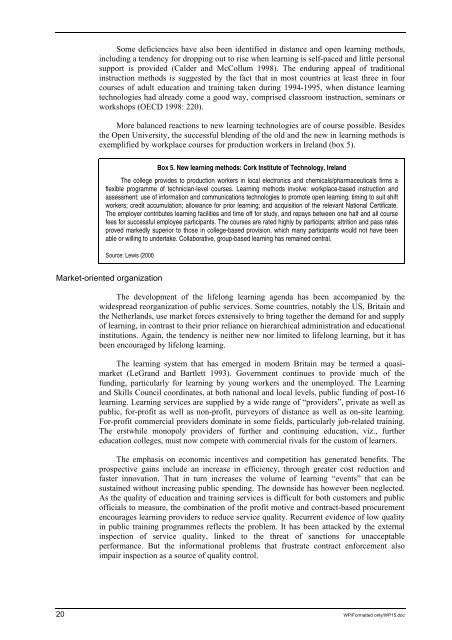Lifelong learning - International Labour Organization
Lifelong learning - International Labour Organization
Lifelong learning - International Labour Organization
You also want an ePaper? Increase the reach of your titles
YUMPU automatically turns print PDFs into web optimized ePapers that Google loves.
Some deficiencies have also been identified in distance and open <strong>learning</strong> methods,<br />
including a tendency for dropping out to rise when <strong>learning</strong> is self-paced and little personal<br />
support is provided (Calder and McCollum 1998). The enduring appeal of traditional<br />
instruction methods is suggested by the fact that in most countries at least three in four<br />
courses of adult education and training taken during 1994-1995, when distance <strong>learning</strong><br />
technologies had already come a good way, comprised classroom instruction, seminars or<br />
workshops (OECD 1998: 220).<br />
More balanced reactions to new <strong>learning</strong> technologies are of course possible. Besides<br />
the Open University, the successful blending of the old and the new in <strong>learning</strong> methods is<br />
exemplified by workplace courses for production workers in Ireland (box 5).<br />
Box 5. New <strong>learning</strong> methods: Cork Institute of Technology, Ireland<br />
The college provides to production workers in local electronics and chemicals/pharmaceuticals firms a<br />
flexible programme of technician-level courses. Learning methods involve: workplace-based instruction and<br />
assessment; use of information and communications technologies to promote open <strong>learning</strong>; timing to suit shift<br />
workers; credit accumulation; allowance for prior <strong>learning</strong>; and acquisition of the relevant National Certificate.<br />
The employer contributes <strong>learning</strong> facilities and time off for study, and repays between one half and all course<br />
fees for successful employee participants. The courses are rated highly by participants; attrition and pass rates<br />
proved markedly superior to those in college-based provision, which many participants would not have been<br />
able or willing to undertake. Collaborative, group-based <strong>learning</strong> has remained central.<br />
Source: Lewis (2000<br />
Market-oriented organization<br />
The development of the lifelong <strong>learning</strong> agenda has been accompanied by the<br />
widespread reorganization of public services. Some countries, notably the US, Britain and<br />
the Netherlands, use market forces extensively to bring together the demand for and supply<br />
of <strong>learning</strong>, in contrast to their prior reliance on hierarchical administration and educational<br />
institutions. Again, the tendency is neither new nor limited to lifelong <strong>learning</strong>, but it has<br />
been encouraged by lifelong <strong>learning</strong>.<br />
The <strong>learning</strong> system that has emerged in modern Britain may be termed a quasimarket<br />
(LeGrand and Bartlett 1993). Government continues to provide much of the<br />
funding, particularly for <strong>learning</strong> by young workers and the unemployed. The Learning<br />
and Skills Council coordinates, at both national and local levels, public funding of post-16<br />
<strong>learning</strong>. Learning services are supplied by a wide range of “providers”, private as well as<br />
public, for-profit as well as non-profit, purveyors of distance as well as on-site <strong>learning</strong>.<br />
For-profit commercial providers dominate in some fields, particularly job-related training.<br />
The erstwhile monopoly providers of further and continuing education, viz., further<br />
education colleges, must now compete with commercial rivals for the custom of learners.<br />
The emphasis on economic incentives and competition has generated benefits. The<br />
prospective gains include an increase in efficiency, through greater cost reduction and<br />
faster innovation. That in turn increases the volume of <strong>learning</strong> “events” that can be<br />
sustained without increasing public spending. The downside has however been neglected.<br />
As the quality of education and training services is difficult for both customers and public<br />
officials to measure, the combination of the profit motive and contract-based procurement<br />
encourages <strong>learning</strong> providers to reduce service quality. Recurrent evidence of low quality<br />
in public training programmes reflects the problem. It has been attacked by the external<br />
inspection of service quality, linked to the threat of sanctions for unacceptable<br />
performance. But the informational problems that frustrate contract enforcement also<br />
impair inspection as a source of quality control.<br />
20 WP/Formatted only/WP15.doc

















